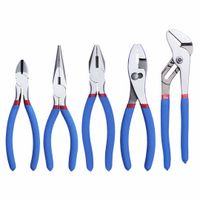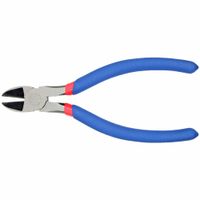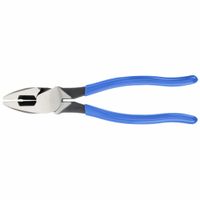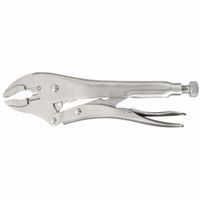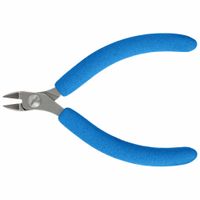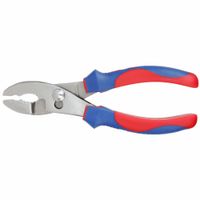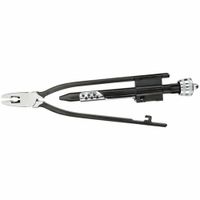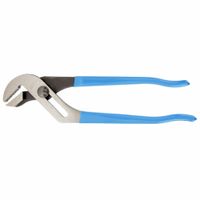Call +(254) 703 030 000 / 751 483 999 / 721 704 777
- Home
- Tools
- Hand Tools
- Pliers
.....Read More
Frequently Asked Questions
What are the different types of pliers and their uses?
There are several types of pliers, each designed for specific tasks:
1. **Slip-Joint Pliers**: These have adjustable jaws, allowing for different grip sizes. They are versatile and used for gripping and bending hardware.
2. **Needle-Nose Pliers**: Characterized by their long, slender jaws, they are ideal for precision work, such as bending wire or reaching into tight spaces.
3. **Diagonal Pliers**: Also known as wire cutters, they are used for cutting wire and small pins in areas that are hard to reach with other tools.
4. **Lineman’s Pliers**: These have a robust design with a gripping surface and cutting edge, used by electricians for twisting, bending, and cutting wire.
5. **Locking Pliers (Vise-Grips)**: These can be locked into position, providing a strong grip. They are used for holding objects firmly in place.
6. **Tongue-and-Groove Pliers**: Often called channel locks, they have adjustable jaws and are used for gripping irregularly shaped objects.
7. **Bent-Nose Pliers**: Similar to needle-nose pliers but with angled jaws, they are used for reaching around obstructions.
8. **Round-Nose Pliers**: With rounded jaws, they are used in jewelry making and for creating loops in wire.
9. **Flat-Nose Pliers**: These have flat, wide jaws and are used for gripping and bending metal without marring the surface.
10. **Snap-Ring Pliers**: Designed for installing or removing snap rings, they have tips that fit into the holes of the rings.
11. **Fencing Pliers**: Multi-functional, they can cut wire, hammer staples, and grip fencing materials.
Each type of plier is designed to provide the best leverage and grip for its intended use, making them essential tools in various trades and DIY projects.
How do you choose the right pliers for a specific task?
To choose the right pliers for a specific task, consider the following factors:
1. **Task Requirements**: Identify the specific task you need to perform. Different tasks require different types of pliers, such as cutting, gripping, bending, or crimping.
2. **Pliers Type**:
- **Slip-Joint Pliers**: Versatile for general gripping and turning.
- **Needle-Nose Pliers**: Ideal for precision work in tight spaces.
- **Diagonal Cutting Pliers**: Best for cutting wires and small pins.
- **Lineman’s Pliers**: Suitable for electrical work, cutting, and twisting wires.
- **Locking Pliers (Vise-Grips)**: Useful for holding objects firmly in place.
- **Tongue-and-Groove Pliers**: Good for gripping irregularly shaped objects.
3. **Material and Durability**: Choose pliers made from high-quality materials like chrome vanadium or carbon steel for durability and strength. Consider corrosion-resistant coatings for longevity.
4. **Size and Ergonomics**: Select pliers that fit comfortably in your hand. Ergonomic handles reduce hand fatigue and improve grip. The size should match the scale of the task; larger pliers for heavy-duty tasks and smaller ones for precision work.
5. **Jaw Design**: The jaw design should match the task. Serrated jaws provide better grip, while smooth jaws prevent surface damage.
6. **Cutting Edge**: For cutting tasks, ensure the pliers have sharp, hardened cutting edges. Check for precision alignment to ensure clean cuts.
7. **Adjustability**: Some pliers offer adjustable jaws for versatility in handling different sizes of objects.
8. **Safety Features**: Insulated handles are essential for electrical work to prevent electric shock.
By evaluating these factors, you can select the most appropriate pliers for your specific task, ensuring efficiency and safety.
What are tongue-and-groove pliers used for?
Tongue-and-groove pliers, also known as channel locks or adjustable pliers, are versatile hand tools used for gripping and turning objects of various sizes. They feature a unique design with an adjustable pivot point that allows the jaws to open wider than standard pliers, making them suitable for a range of tasks. The primary uses of tongue-and-groove pliers include:
1. **Plumbing Tasks**: They are commonly used in plumbing to grip and turn pipes, fittings, and nuts. Their adjustable jaws can accommodate different pipe sizes, making them ideal for tightening or loosening plumbing connections.
2. **Automotive Repairs**: In automotive work, these pliers are used to grip and turn components like hoses, clamps, and bolts. Their ability to adjust to different sizes makes them useful for various automotive applications.
3. **Electrical Work**: Electricians use tongue-and-groove pliers to manipulate conduit and other electrical components. The pliers' design allows for a firm grip on round or irregularly shaped objects.
4. **General Maintenance and Repair**: These pliers are handy for general maintenance tasks around the home or workshop, such as assembling furniture, repairing appliances, or performing DIY projects. They can grip and turn screws, bolts, and other fasteners.
5. **Construction and Carpentry**: In construction, they are used to hold and manipulate building materials, such as wood or metal, during assembly or installation.
6. **HVAC Applications**: HVAC technicians use them to adjust and secure ductwork, fittings, and other components in heating, ventilation, and air conditioning systems.
The adjustable nature and strong grip of tongue-and-groove pliers make them an essential tool in many toolkits, providing flexibility and efficiency across various trades and applications.
How do diagonal-cutting pliers differ from other cutting pliers?
Diagonal-cutting pliers, often referred to as "diagonal pliers" or "side cutters," are specifically designed for cutting wire and small pins in areas that are difficult to reach with other types of cutting tools. The key distinguishing feature of diagonal-cutting pliers is their cutting edges, which are set at an angle (typically around 15 to 20 degrees) relative to the handles. This angled design allows for a flush cut, meaning the tool can cut close to a surface without leaving a protruding end, which is particularly useful in electrical work and precision tasks.
In contrast, other cutting pliers, such as lineman's pliers or end-cutting pliers, have different designs and purposes. Lineman's pliers, for example, have a broader, flat gripping surface and are used for gripping, twisting, bending, and cutting wire. They are more versatile but less specialized for flush cutting. End-cutting pliers, on the other hand, have cutting edges that are perpendicular to the handles, making them ideal for cutting nails, bolts, and rivets, but they cannot achieve the same flush cut as diagonal pliers.
Diagonal-cutting pliers are typically smaller and lighter than other cutting pliers, making them easier to handle in tight spaces. They are commonly used by electricians, jewelers, and hobbyists for tasks that require precision and a clean cut. The cutting edges of diagonal pliers are hardened to cut through various materials, including copper, aluminum, and steel wire, but they are not suitable for cutting hardened steel or large-gauge wires, which could damage the tool.
Overall, the primary difference lies in the design and intended use: diagonal-cutting pliers are specialized for precision cutting in tight spaces, while other cutting pliers offer broader functionality for different tasks.
What are the benefits of using precision-cutting pliers?
Precision-cutting pliers offer several benefits, particularly in tasks requiring accuracy and finesse. Firstly, they provide enhanced control and precision, allowing users to make clean, accurate cuts in small or delicate components, which is essential in electronics, jewelry making, and intricate craftwork. The sharp, finely honed blades of precision-cutting pliers ensure minimal damage to surrounding materials, reducing the risk of errors and rework.
Secondly, these pliers are designed with ergonomic handles that reduce hand fatigue, enabling prolonged use without discomfort. This is particularly beneficial for professionals who require extended periods of tool use. The ergonomic design also enhances grip, ensuring stability and reducing the likelihood of slipping, which can lead to mistakes or injury.
Additionally, precision-cutting pliers are often made from high-quality materials such as hardened steel, which ensures durability and longevity. This means they maintain their sharpness over time, providing consistent performance and reducing the need for frequent replacements. The durability also translates to cost-effectiveness, as the tools require less maintenance and have a longer lifespan.
Moreover, precision-cutting pliers are versatile and can be used across various applications, from cutting wires and cables to trimming plastic and metal components. This versatility makes them a valuable addition to any toolkit, whether for professional or hobbyist use.
Finally, the compact size of precision-cutting pliers makes them easy to handle and maneuver in tight spaces, which is crucial in tasks involving intricate assemblies or confined areas. This compactness also facilitates easy storage and transport, adding to their convenience and practicality.
How do you maintain and care for pliers?
To maintain and care for pliers, follow these steps:
1. **Cleaning**: After each use, wipe the pliers with a clean, dry cloth to remove dirt, grease, and debris. For stubborn grime, use a mild detergent and water, then dry thoroughly to prevent rust.
2. **Lubrication**: Apply a light machine oil or a specialized tool lubricant to the pivot joint regularly. This ensures smooth operation and prevents rust. Wipe off any excess oil to avoid attracting dust.
3. **Rust Prevention**: Store pliers in a dry place. Consider using silica gel packs in your toolbox to absorb moisture. If rust appears, remove it with fine steel wool or a rust remover.
4. **Inspection**: Regularly check for wear and damage. Ensure the jaws align properly and the cutting edges are sharp. Misaligned jaws or dull edges can compromise performance and safety.
5. **Sharpening**: For pliers with cutting edges, use a fine file or sharpening stone to maintain sharpness. Follow the original bevel angle to avoid damaging the tool.
6. **Storage**: Store pliers in a toolbox or on a pegboard to prevent damage. Avoid tossing them into a drawer where they can become nicked or bent.
7. **Handle Care**: Inspect the handles for cracks or wear. Replace grips if they are damaged to ensure a secure hold and prevent slippage.
8. **Avoid Misuse**: Use pliers only for their intended purpose. Avoid using them as hammers or prying tools, which can damage the tool and reduce its lifespan.
By following these steps, you can extend the life of your pliers and ensure they remain effective and safe to use.
What safety precautions should be taken when using pliers?
When using pliers, several safety precautions should be observed to prevent injury and ensure effective use:
1. **Select the Right Pliers**: Use the appropriate type and size of pliers for the task. Using the wrong pliers can lead to slippage or damage to the tool and workpiece.
2. **Inspect Before Use**: Check for any damage, such as cracks or worn-out grips. Ensure the pliers are clean and free from oil or grease to prevent slipping.
3. **Wear Protective Gear**: Use safety glasses to protect your eyes from flying debris. Gloves can provide additional grip and protect your hands from sharp edges.
4. **Proper Grip**: Hold the pliers firmly but not excessively tight. Ensure your hand is positioned correctly to avoid pinching your skin between the handles.
5. **Avoid Overloading**: Do not use pliers as a wrench or hammer. Applying excessive force can damage the tool or cause it to slip, leading to injury.
6. **Cutting Safety**: When cutting wire or other materials, ensure the cutting edges are sharp and aligned. Cut away from your body and ensure no one is in the path of the cut material.
7. **Avoid Electrical Hazards**: Do not use pliers on live electrical circuits unless they are specifically insulated for electrical work.
8. **Storage**: Store pliers in a dry place to prevent rust. Keep them in a tool box or on a pegboard to avoid clutter and potential accidents.
9. **Maintenance**: Regularly clean and lubricate the pivot joint to ensure smooth operation. Replace pliers if they become damaged or worn out.
10. **Awareness**: Be aware of your surroundings and ensure you have a stable footing to prevent accidents while using pliers.
